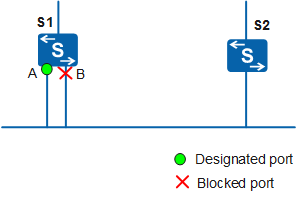Election Rules of the STP Root Bridge, Root Port, and Designated Port
On an STP network, the root bridge, root port, and designated port are selected based on the BPDU priority vector {root ID, root path cost, sender BID, PID}, as described in Table 1.
Field |
Description |
|---|---|
Root ID |
ID of the root bridge. |
Root path cost |
Path cost to the root bridge. The distance between the port sending the configuration BPDU and the root bridge determines the path cost. |
Sender BID |
BID of the device that sends configuration BPDUs. |
PID |
PID of the port that sends configuration BPDUs. |
Upon receipt of a configuration BPDU, a device on an STP network compares the fields listed in Table 1 with its own values. The compared information is as follows:
- Smallest BID: used to select the root bridge. STP-capable devices select the device with the smallest BID based on the root ID field in Table 1.
- Smallest root path cost: used to select the root port on a non-root bridge. On the root bridge, the path cost of each port is 0.
- Smallest sender BID: used to select the root port from ports with the same root path cost. The port with the smallest BID is selected as the root port in STP calculation.
- Smallest PID: used to determine which port should be blocked when multiple ports have the same root path cost. The port with the largest PID is blocked. A scenario where PIDs are compared is shown in Figure 1. The BPDUs received on ports A and B of S1 both contain the same root path cost and sender BID. However, port A has a smaller PID than port B. Therefore, port B is blocked to prevent loops.
After the root bridge, root port, and designated ports are selected successfully, a tree topology is set up on the entire network. When the topology is stable, only the root port and designated ports forward traffic. The other ports are in Blocking state; they only receive STP BPDUs and do not forward user traffic.
